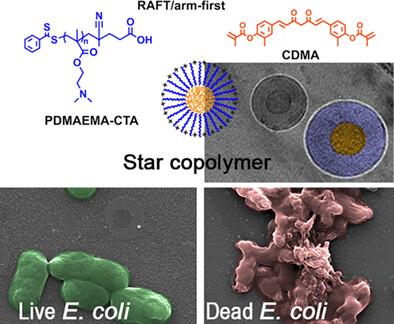Madson RE Santos, Clara LB Fidelis, Flávia S Zandonadi, Fernando C Giacomelli, Maria Isabel Felisberti
求助PDF
{"title":"Amphiphilic star copolymers composed of curcumin core for bacterial inactivation","authors":"Madson RE Santos, Clara LB Fidelis, Flávia S Zandonadi, Fernando C Giacomelli, Maria Isabel Felisberti","doi":"10.1002/pi.6565","DOIUrl":null,"url":null,"abstract":"<p>Polymeric materials with antimicrobial properties hold the potential to be the next generation of therapeutics. This work reports the preparation of amphiphilic and star-like copolymers through arm-first and reversible addition–fragmentation chain transfer polymerization. The copolymers composed of poly(dimethylamine ethyl methacrylate) (PDMAEMA) as the arms and poly(curcumin dimethacrylate) (PCDMA) as the crosslinked core presented a well-controlled amphiphilic structure with low dispersity values (<i>Ð</i> = 1.15). Varying the [CDMA]:[PDMAEMA] molar ratios (4, 6 and 8) led to a significant increase in the molar mass (153, 688 and 1550 kDa), particle size (33, 90 and 105 nm) and the average number of PDMAEMA arms anchored to the curcumin-based core (12, 52 and 125 arms), as determined by dynamic and static light scattering. The antimicrobial activity of cationic PDMAEMA<sub>40</sub>-<i>co</i>-PCDMA<sub>core</sub> was tested against <i>Escherichia coli</i> in the absence of light and under white light to investigate the photodynamic activity of the copolymers. The results demonstrated a concentration dependence but no additional effect under light irradiation. SEM imaging and live/dead assays revealed extensive membrane damage, evidencing a membrane-disruption mechanism. HeLa viability assays demonstrated that at 1 mg mL<sup>−1</sup>, 80 ± 10% of the cells demonstrated metabolic activity after 24 h. © 2023 Society of Industrial Chemistry.</p>","PeriodicalId":20404,"journal":{"name":"Polymer International","volume":"73 1","pages":"21-29"},"PeriodicalIF":2.9000,"publicationDate":"2023-07-25","publicationTypes":"Journal Article","fieldsOfStudy":null,"isOpenAccess":false,"openAccessPdf":"","citationCount":"0","resultStr":null,"platform":"Semanticscholar","paperid":null,"PeriodicalName":"Polymer International","FirstCategoryId":"92","ListUrlMain":"https://onlinelibrary.wiley.com/doi/10.1002/pi.6565","RegionNum":4,"RegionCategory":"化学","ArticlePicture":[],"TitleCN":null,"AbstractTextCN":null,"PMCID":null,"EPubDate":"","PubModel":"","JCR":"Q2","JCRName":"POLYMER SCIENCE","Score":null,"Total":0}
引用次数: 0
引用
批量引用
Abstract
Polymeric materials with antimicrobial properties hold the potential to be the next generation of therapeutics. This work reports the preparation of amphiphilic and star-like copolymers through arm-first and reversible addition–fragmentation chain transfer polymerization. The copolymers composed of poly(dimethylamine ethyl methacrylate) (PDMAEMA) as the arms and poly(curcumin dimethacrylate) (PCDMA) as the crosslinked core presented a well-controlled amphiphilic structure with low dispersity values (Ð = 1.15). Varying the [CDMA]:[PDMAEMA] molar ratios (4, 6 and 8) led to a significant increase in the molar mass (153, 688 and 1550 kDa), particle size (33, 90 and 105 nm) and the average number of PDMAEMA arms anchored to the curcumin-based core (12, 52 and 125 arms), as determined by dynamic and static light scattering. The antimicrobial activity of cationic PDMAEMA40 -co -PCDMAcore was tested against Escherichia coli in the absence of light and under white light to investigate the photodynamic activity of the copolymers. The results demonstrated a concentration dependence but no additional effect under light irradiation. SEM imaging and live/dead assays revealed extensive membrane damage, evidencing a membrane-disruption mechanism. HeLa viability assays demonstrated that at 1 mg mL−1 , 80 ± 10% of the cells demonstrated metabolic activity after 24 h. © 2023 Society of Industrial Chemistry.
姜黄素核两亲性星形共聚物用于细菌灭活
具有抗菌特性的聚合物材料有望成为下一代治疗药物。这项研究报告了通过先臂聚合和可逆加成-碎片链转移聚合制备两亲性星状共聚物的过程。以聚(甲基丙烯酸二甲胺基乙酯)(PDMAEMA)为臂、聚(姜黄素二甲基丙烯酸酯)(PCDMA)为交联核的共聚物呈现出良好的两亲结构,分散度较低(Ð = 1.15)。改变[CDMA]:[PDMAEMA]摩尔比(4、6 和 8)可显著增加摩尔质量(153、688 和 1550 kDa)、粒度(33、90 和 105 nm)以及锚定在姜黄素基核心上的 PDMAEMA 臂的平均数量(12、52 和 125 臂),这是由动态和静态光散射法测定的。测试了阳离子 PDMAEMA40-co-PCDMAcore 在无光和白光下对大肠杆菌的抗菌活性,以研究共聚物的光动力活性。结果表明这种共聚物具有浓度依赖性,但在光照射下没有额外效果。扫描电子显微镜成像和活/死试验显示了广泛的膜损伤,证明了膜破坏机制。HeLa 细胞存活率测定显示,在 1 mg mL-1 的浓度下,80 ± 10% 的细胞在 24 小时后表现出代谢活性。 © 2023 工业化学学会。
本文章由计算机程序翻译,如有差异,请以英文原文为准。


 求助内容:
求助内容: 应助结果提醒方式:
应助结果提醒方式:


